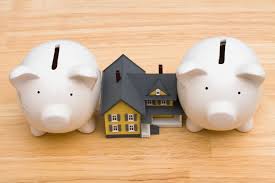What is a Piggyback Mortgage?
 As the name suggests, piggyback mortgage is basically two loans on top of each other. In other words, a borrower takes out two mortgage simultaneously where the second mortgage is home equity loan or the line of credit. Piggyback mortgages are a good option for people who want to avoid paying Private mortgage insurance (PMI) and higher FHA fees. It is also known as “80-10-10” loan where:
As the name suggests, piggyback mortgage is basically two loans on top of each other. In other words, a borrower takes out two mortgage simultaneously where the second mortgage is home equity loan or the line of credit. Piggyback mortgages are a good option for people who want to avoid paying Private mortgage insurance (PMI) and higher FHA fees. It is also known as “80-10-10” loan where:
- 80% refers to percentage of purchase price that primary mortgage will cover. If you want to avoid PMI, it must be less than or equal to 80 %.
- 10% refers to the percentage of purchase price that will be covered by the second mortgage that is in the form of home equity loan or the line of credit.
- 10% refers to the final percentage purchase price that will be covered by the down payment.
What are the benefits of piggyback mortgage?
1. Piggyback mortgage are commonly used by borrowers who don’t have enough money to put in as 20 percent down payment. In a traditional loan, if a borrower makes a down payment of less than 20 percent, lenders look for mortgage insurance to cover for their losses if the borrower defaults on the payments. Piggyback loans allow you to avoid PMI and that translates into low monthly payments. How does it work? How do piggyback loans eliminate PMI? It is because piggyback loans lower the loan-to-value ratio (LTV) of a first mortgage to under 80% – allowing the borrower to avoid private mortgage insurance (PMI).
Related article: Reasons To Avoid Private Mortgage Insurance.
2. Piggyback loans help you to avoid going above the conforming loan limit. You would want to avoid a jumbo loan that has higher interest rate. A loan is classified as a jumbo loan it if it exceeds the conforming loan limit. For most counties, this confirming limit stands at $417,000. How does it work? Lenders construct the two mortgages in such a way that the first mortgage is set for an amount that doesn’t exceed the conforming limit while lending the rest of the loan amount as the second mortgage. The entire loan amount is split into two loans where the borrower gets a lower interest rate for the major part of his loan amount while a smaller portion of the loan bears a higher interest rate.
What are things to remember before going for a piggyback mortgage?
1. In the long run, the second mortgage might end up costing more. It is because the second loan is basically a home equity line of credit (HELOC), which may carry a higher interest rate. Piggyback loans are great when the rates are currently low. But the second mortgage, most often than not, works on a variable rate. So, if the prime rate ever changes and goes up, it is going to impact your cost savings as you will end up paying higher interest rates.
2. Piggyback mortgages are typically difficult to refinance later. During an agreement known as re-subordination, the home equity lender or the lender on the second mortgage agrees to remain in a position subordinated to the first lien lender. That means the second mortgage will need to be paid off.
3. Second mortgage cannot be cancelled while you can request your lender to cancel your private mortgage insurance payments after certain criteria are met. What are these criteria? Read What is PMI and How Does it Work? to find out.
4. Although a minor convenience when you look at the benefits, going for a piggyback loan means you will be making two different payments on two loans.
5. After the housing bubble debacle in 2008, lenders have made the qualification requirements more stringent and now it is not as easy to qualify for piggyback loans. It requires a strong credit score, somewhere close to 700. Lenders also need you to have a total debt-to-income ratio of no more than 43 percent and expect that you have some cash stacked up.
6. If your second mortgage is large, you may not be eligible for full tax benefits. The tax deduction only applies for that part of the loan that is less than $100,000.
Related article: Reduction in FHA annual premiums in 2015: What does it mean to you?